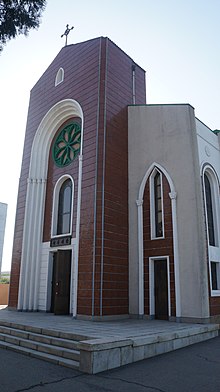Changchung Cathedral
| Changchung Cathedral | |
|---|---|

Exterior of Changchung Cathedral
|
|
| Basic information | |
| Location | Changchung, Songyo-guyok, Pyongyang, North Korea |
| Geographic coordinates | 39°00′25″N 125°46′40″E / 39.00694°N 125.77778°ECoordinates: 39°00′25″N 125°46′40″E / 39.00694°N 125.77778°E |
| Affiliation | North Korean Catholics |
| Country | North Korea |
| Ecclesiastical or organizational status | Cathedral |
| Status | No bishop |
| Leadership | Korean Catholic Association |
| Completed | 1988 |
| Changchung Cathedral | |
| Chosŏn'gŭl | 장충성당 |
|---|---|
| Hancha | |
| Revised Romanization | Jangchung-seongdang |
| McCune–Reischauer | Changch'ung-sŏngdang |
Changchung Cathedral is the nominal cathedral of the Roman Catholic Bishop of Pyongyang, North Korea, located in the Changchung neighborhood of Songyo-guyok, Pyongyang. It is one of only four official Christian places of worship in Pyongyang. It operates under the Korean Catholic Association.
Before the division of Korea, Pyongyang was the city with the highest number of Christian believers in Korea, and was known as the "Korean Jerusalem". By 1945, nearly 1/6 of its citizens were Christians. Therefore, Pyongyang was made into the only diocese in northern Korea.
After the division of Korea, however, the Communist government under Kim Il-sung persecuted Christians as imperialist collaborators and spies; even the famous Christian Nationalist Cho Man-sik, initially more influential than Kim, was arrested and shot. Much of the Catholic community was either killed or imprisoned, and many more fled south.
The original cathedral, built of red brick in the late 19th century, was destroyed in the Korean War by American forces. Earlier, in 1949, the last formal Bishop of Pyongyang, Francis Hong Yong-ho, had been imprisoned by the communist government; he later disappeared.
In 1988 a new cathedral was opened in East Pyongyang. At the same time, two nondenominational "protestant" churches were opened in an effort by the government to show religious freedom.
The cathedral currently has no bishop or even an ordained priest, as Pyongyang has strained relations with the Holy See. There is no resident priest. Masses are held in the presence of foreign clergy.
There is a noodle factory associated with the church that receives financial support from the Roman Catholic Archdiocese of Seoul and Catholic Koreans in the United States.
...
Wikipedia

